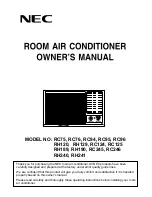
62
English
Instal
lation Pr
oc
edur
e
1
Before supplying the power, use DC 500 V insulation resistance
tester to measure the power (3 phase: R, S, T/ 1 phase: L, N)
terminal and the outdoor unit grounding.
–
Measurement should be over 30MΩ.
2
Before supplying the power, use a voltmeter and phase tester
to check the voltage and the phase.
–
R, S, T, N terminal: check if the voltage is within 380-415 V
between wires (R-S, S-T, T-R) and 200-
240 V between phases (R-N, S-N, T-N)
before turning on the switch.
CAUTION
• Never measure the communication terminal since
communication circuit may get damaged.
• Check for short-circuit of the communication terminal with a
general circuit tester.
N
T
S
R
< ELB >
230V
400V
400V
400V
230V 230V
3
Check if the R-410A indoor units are connected.
4
When N phase is not correctly connected to R, S and T phase,
over-voltage protection control will be in effect and it will cut-
off the power of the PCB. Check the power cable connection of
the N phase if the PCB is not turned on.
5
Check the following after the installation is completed.
Performing final checks and trial operation
Installation work
Outdoor unit
• Have you checked the external surface and the inside of the outdoor unit?
• Is there any possibility of short-circuit caused by the heat of an outdoor unit?
• Is the place well-ventilated and ensures space for service?
• Is the outdoor unit fixed securely to withstand any external force?
Indoor unit
• Have you checked the external surface and the inside of the indoor unit?
• Is there enough space for service?
• Have you checked if the center of the indoor unit is ensured and it is installed horizontally?
Refrigerant pipe work
• Have you selected correct pipes?
• Are the liquid and gas valve open?
• Is the total number of connected indoor units within the allowable range?
• Are the length and the height difference between the refrigerant pipes within the allowable range?
• Are the branch joints properly installed?
• Did you check the connection of liquid and gas pipes?
• Have you selected correct insulator for pipes and insulated them correctly?
• Did you insulate the pipes and connection part correctly?
• Is the quantity of the additional refrigerant correctly weighed in? (You must record the amount of
additional refrigerant on the service record paper placed inside of the outdoor unit.)
Drain pipe work
• Have you checked if the drain pipes of the indoor and outdoor unit are connected together?
• Have you completed the drain test?
• Is the drain pipe properly insulated?
Electrical wiring work
• Are the power cable and communication cable tightened firmly on the terminal board within the
range of rated tightening torque?
• Have you checked for cross-connection of the power and communication cables?
• Have you performed the earthing work 3 to the outdoor unit?
• Did you make sure to use 2-core cable (not multi-core cable) for the communication cable?
• Is the length of the wire within allowed range?
• Is the wiring route correct?
Setting address
• Did you set the address of the indoor and outdoor units properly?
• Did you set the address of the indoor and outdoor units properly? (When using multiple remote
controllers)
Option
• If there is a possibility of the outdoor unit from vibrating, check whether the anti-vibration frame is
correctly installed.
Summary of Contents for AM AXV Series
Page 68: ......







































